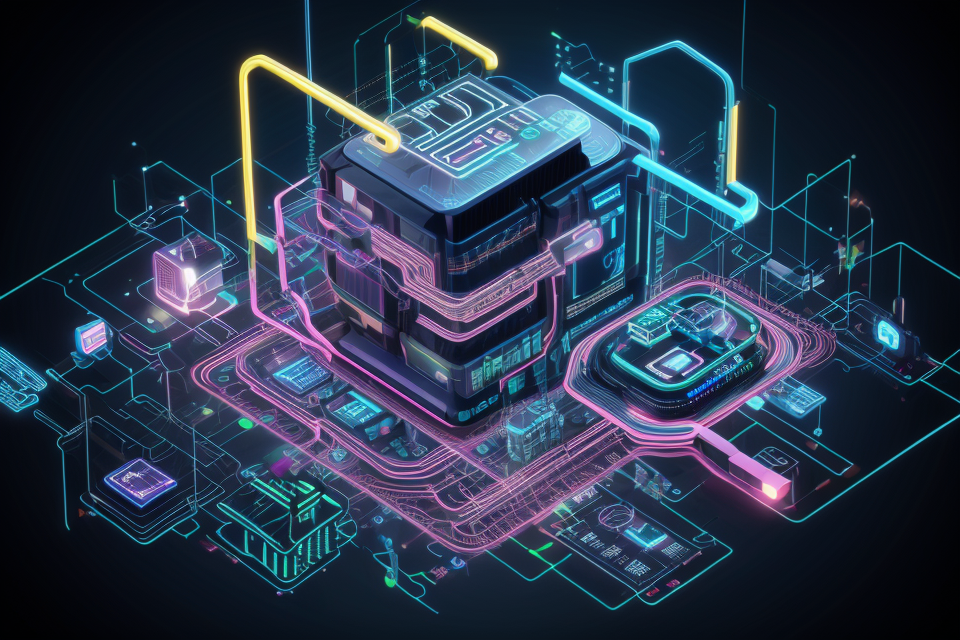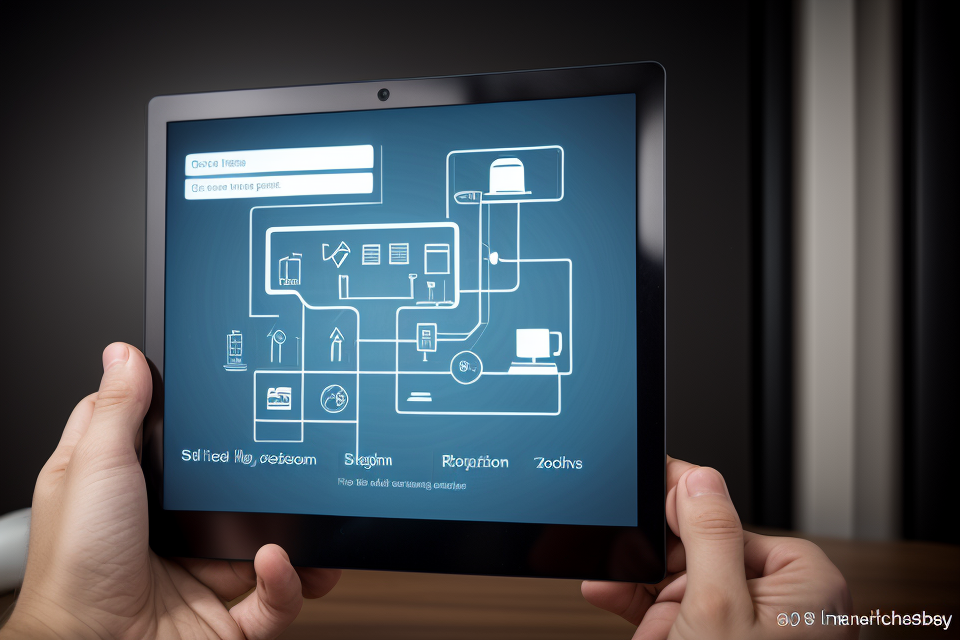The Internet of Things (IoT) is a term used to describe the growing network of physical devices that are connected to the internet and can communicate with each other. From smart home appliances to industrial machines, the IoT is transforming the way we live, work and play. In this article, we will explore what the IoT is, how it works and its potential impact on our lives. We will also discuss the benefits and challenges of this new technology and how it is shaping the future of our world. So, buckle up and get ready to dive into the exciting world of the Internet of Things!
The Internet of Things (IoT) refers to the network of physical devices, vehicles, buildings, and other items embedded with sensors, software, and connectivity to enable these objects to collect and exchange data. IoT allows these devices to connect and communicate with each other and with the cloud, without requiring human intervention. IoT works by connecting these devices to the internet, and using sensors and software to collect and analyze data. This data can then be used to automate processes, make predictions, and improve efficiency. For example, a smart thermostat can learn your temperature preferences and adjust the temperature automatically, or a fitness tracker can track your daily activity and provide insights into your health. Overall, IoT is transforming the way we live and work, enabling new levels of efficiency, convenience, and innovation.
What is the Internet of Things?
Definition of IoT
The Internet of Things (IoT) refers to the interconnection of physical devices, vehicles, buildings, and other objects, which are embedded with sensors, software, and network connectivity, allowing them to collect and exchange data.
IoT differs from other technologies such as the Internet of Computers (IoC), which primarily connects computing devices, and the Internet of People (IoP), which focuses on human interactions and social networks.
Components of IoT
The components of IoT include:
- Devices: These are physical objects that are embedded with sensors, software, and network connectivity. Examples include smart home appliances, wearable devices, and industrial machinery.
- Networks: These are the communication systems that enable devices to connect and exchange data. IoT networks can be wired or wireless and can include cellular networks, Wi-Fi, and Bluetooth.
- Data Analytics: This involves the collection, processing, and analysis of data generated by IoT devices. Data analytics helps businesses and organizations make informed decisions based on insights derived from the data.
- Cloud Computing: This refers to the storage and processing of data in remote servers accessed over the internet. Cloud computing enables IoT devices to store and access data from anywhere at any time.
Applications of IoT
IoT is used in various industries, including:
- Smart Home: IoT devices are used to automate and control various aspects of the home, such as lighting, heating, and security.
- Healthcare: IoT devices are used to monitor patients’ health and provide real-time data to healthcare professionals.
- Industrial: IoT devices are used to monitor and control industrial processes, improving efficiency and reducing downtime.
- Transportation: IoT devices are used to monitor and optimize transportation systems, including traffic management and fleet management.
The potential benefits of IoT include improved efficiency, cost savings, increased productivity, and enhanced decision-making capabilities.
How Does IoT Work?
Device Connection
The Internet of Things (IoT) is a network of interconnected devices that can collect and share data with each other and with other systems. These devices can range from smart home appliances to industrial machinery and vehicles. To connect these devices to the internet, they typically use one of several types of connections, including Wi-Fi, Bluetooth, Zigbee, and cellular networks. Each type of connection has its own advantages and disadvantages, depending on the specific needs of the device and the environment in which it will be used.
Data Collection
Once devices are connected to the internet, they can begin collecting data from their surroundings or from the actions they perform. This data can include information about the device’s own performance, as well as data about the environment in which it is operating. For example, a smart thermostat might collect data about the temperature and humidity in a room, while a fitness tracker might collect data about a person’s heart rate and movement. The ability to collect data from a wide range of sources is one of the key advantages of IoT, as it allows businesses and individuals to gain new insights into their operations and environments.
Data Processing
Once data has been collected from connected devices, it must be processed and analyzed to extract useful insights. This processing can involve a variety of techniques, including machine learning algorithms, statistical analysis, and natural language processing. In addition to these techniques, there are a variety of tools and technologies that can be used to support data processing in IoT, including cloud computing platforms, big data analytics software, and specialized hardware for handling large amounts of data. By using these tools and techniques, businesses and individuals can turn the raw data collected by IoT devices into actionable insights that can inform decision-making and improve operations.
Data Analysis
After data has been collected and processed, it can be analyzed to extract insights and inform decision-making. This analysis can involve a variety of techniques, including predictive modeling, data visualization, and text analysis. In addition to these techniques, there are a variety of tools and technologies that can be used to support data analysis in IoT, including data science platforms, machine learning libraries, and specialized software for visualizing and interpreting data. By using these tools and techniques, businesses and individuals can gain a deeper understanding of the data collected by IoT devices and use that understanding to make more informed decisions.
Action and Automation
One of the key benefits of IoT is its ability to automate processes and improve efficiency. By connecting devices and systems and allowing them to communicate with each other, it is possible to create complex workflows that can automate many tasks and processes. For example, a smart factory might use IoT to automate the movement of goods and materials, while a smart home might use IoT to automate the control of lighting and heating. By automating these processes, businesses and individuals can reduce the need for manual labor and improve the speed and accuracy of their operations. In addition, the ability to collect and analyze data from IoT devices can help businesses and individuals identify opportunities for further automation and process improvement.
Security and Privacy Concerns in IoT
Threats to IoT Security
The Internet of Things (IoT) has brought about numerous benefits to our daily lives, from enhancing efficiency in the workplace to improving the quality of healthcare. However, as more devices are connected to the internet, the security threats facing IoT have become increasingly prominent. There are several types of security threats that pose a risk to IoT devices, including:
- Cyber-attacks: Hackers can gain access to IoT devices through vulnerabilities in their software or hardware, enabling them to manipulate or steal sensitive data.
- Distributed Denial of Service (DDoS) attacks: IoT devices can be used as part of a botnet to launch DDoS attacks, overwhelming a website or network with traffic.
- Data breaches: If an IoT device stores sensitive information, such as personal or financial data, a data breach can have severe consequences.
The potential consequences of a security breach in IoT can be severe. For example, a hacker could gain access to a connected home device, such as a smart thermostat, and use it to access other devices on the network, potentially leading to a full-scale invasion of privacy. Additionally, a successful cyber-attack on a healthcare provider’s IoT system could lead to the exposure of confidential patient data.
Privacy Concerns in IoT
As more and more devices become connected to the internet, privacy concerns surrounding IoT have emerged. There are several privacy concerns surrounding IoT, including:
- Data collection: IoT devices often collect large amounts of data, including personal information, which can be used for targeted advertising or other purposes.
* Data sharing: IoT devices may share data with third-party companies, which can be a potential risk to personal privacy. - Location tracking: Many IoT devices, such as smartphones and smartwatches, have GPS capabilities, which can be used to track a person’s location.
The potential risks to personal data in IoT are significant. For example, a hacker could gain access to a person’s connected fitness tracker and use the data it collects to identify the person’s daily routine and habits. Additionally, a company that collects data from IoT devices could use that data to build a detailed profile of a person’s preferences and behaviors, which could be used for targeted advertising or other purposes.
To address these concerns, it is essential to implement strong security measures and ensure that users are aware of the data that is being collected and how it is being used. Additionally, it is crucial to ensure that IoT devices are designed with privacy in mind, including implementing end-to-end encryption and allowing users to control what data is collected and shared.
Future of IoT
The Internet of Things (IoT) is an ever-evolving field that is poised for significant growth and development in the coming years. Here are some of the expected advancements in IoT technology and their potential impact on various industries.
Expected Developments in IoT
Advances in Connectivity
One of the key areas of development in IoT is connectivity. As more devices become connected to the internet, the need for faster and more reliable connectivity becomes increasingly important. This is leading to the development of new technologies such as 5G, which promises to provide faster speeds and lower latency, making it ideal for use in IoT applications.
Increased Adoption of Edge Computing
Edge computing is a distributed computing paradigm that allows data to be processed closer to its source, rather than being sent to a centralized data center. This can help reduce latency and improve the efficiency of IoT systems. As more devices become connected, the demand for edge computing is likely to increase, driving further development in this area.
Advancements in Artificial Intelligence and Machine Learning
Artificial intelligence (AI) and machine learning (ML) are increasingly being used in IoT applications to analyze data and make predictions. As more data is generated by IoT devices, the potential for AI and ML to provide valuable insights is growing. This is likely to drive further development in these areas, as companies seek to take advantage of the opportunities presented by IoT data.
Development of New Devices and Applications
As IoT technology continues to advance, we can expect to see the development of new devices and applications that take advantage of these advancements. This could include everything from smart homes and cities to new industrial applications and healthcare solutions. The potential for IoT to transform industries and improve lives is enormous, and we can expect to see significant growth in this area in the coming years.
Challenges and Opportunities in IoT
While there are many opportunities for growth and innovation in IoT, there are also several challenges that must be addressed. Here are some of the key challenges facing the growth of IoT and the opportunities for innovation that they present.
Security and Privacy Concerns
One of the biggest challenges facing IoT is security and privacy concerns. As more devices become connected to the internet, the potential for cyber attacks and data breaches increases. This is leading to the development of new security technologies and practices, as well as increased emphasis on privacy and data protection.
Interoperability and Standards
Another challenge facing IoT is the need for interoperability and standards. As more devices become connected, the need for common standards and protocols becomes increasingly important. This is necessary to ensure that devices from different manufacturers can communicate with each other and work together seamlessly.
Data Management and Analytics
The growth of IoT is also driving the need for new data management and analytics technologies. As more data is generated by IoT devices, the need for tools to manage and analyze this data becomes increasingly important. This is driving the development of new technologies and practices for data management and analytics, as well as increased emphasis on data privacy and protection.
Overall, the future of IoT is full of opportunities for growth and innovation, but also presents several challenges that must be addressed. As the field continues to evolve, it will be important to stay abreast of these developments and to be prepared to adapt to the changing landscape.
FAQs
1. What is the Internet of Things (IoT)?
The Internet of Things (IoT) refers to the growing network of physical devices, vehicles, home appliances, and other items embedded with electronics, software, sensors, and connectivity which enables these objects to connect and exchange data with each other and with the internet. IoT allows for the seamless integration of technology into everyday life, creating new opportunities for efficiency, automation, and innovation.
2. How does the Internet of Things work?
The Internet of Things (IoT) works by connecting devices to the internet and enabling them to communicate with each other and with other systems. This is achieved through the use of sensors, software, and connectivity technologies such as Wi-Fi, Bluetooth, and cellular networks. Data is collected from the devices and transmitted to cloud-based platforms for analysis and processing. This allows for real-time monitoring, predictive maintenance, and automation of processes, leading to increased efficiency and productivity.
3. What are some examples of IoT devices?
Some examples of IoT devices include smart thermostats, wearable fitness trackers, smart home security systems, industrial sensors, and connected cars. These devices are equipped with sensors and connectivity technologies that enable them to collect and transmit data, allowing for greater control and automation of various processes.
4. What are the benefits of IoT?
The benefits of IoT include increased efficiency, cost savings, improved safety, and enhanced customer experiences. IoT enables real-time monitoring and analysis of data, leading to better decision-making and automation of processes. It also allows for predictive maintenance, reducing downtime and maintenance costs. In addition, IoT can improve safety by detecting potential issues before they become serious problems. Finally, IoT can enhance customer experiences by providing personalized services and improving the overall user experience.
5. What are some challenges associated with IoT?
Some challenges associated with IoT include data security and privacy concerns, interoperability issues, and the need for reliable connectivity. As IoT devices collect and transmit sensitive data, it is important to ensure that appropriate security measures are in place to protect against cyber threats. Additionally, ensuring that IoT devices from different manufacturers can communicate with each other can be a challenge. Finally, providing reliable connectivity to IoT devices in remote or hard-to-reach locations can be difficult.



